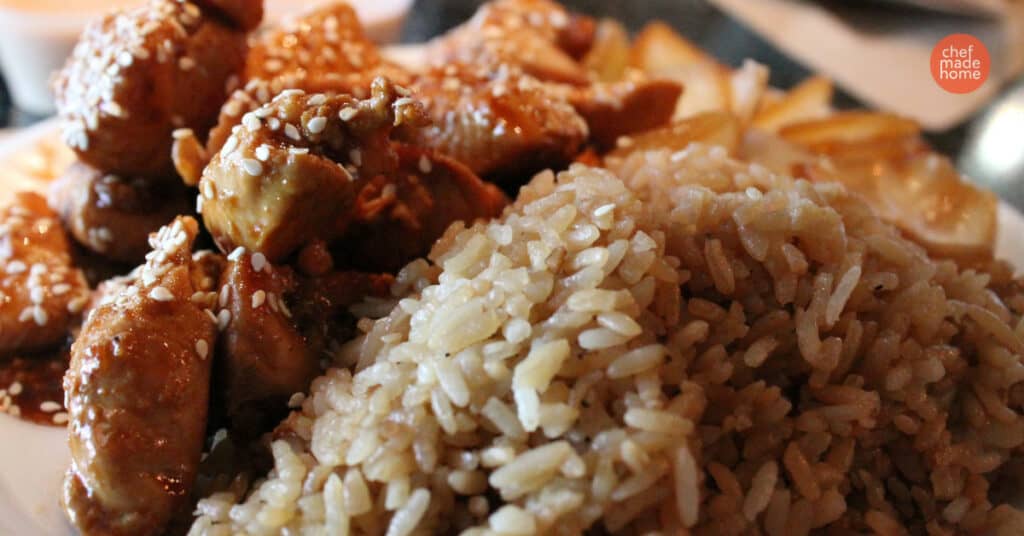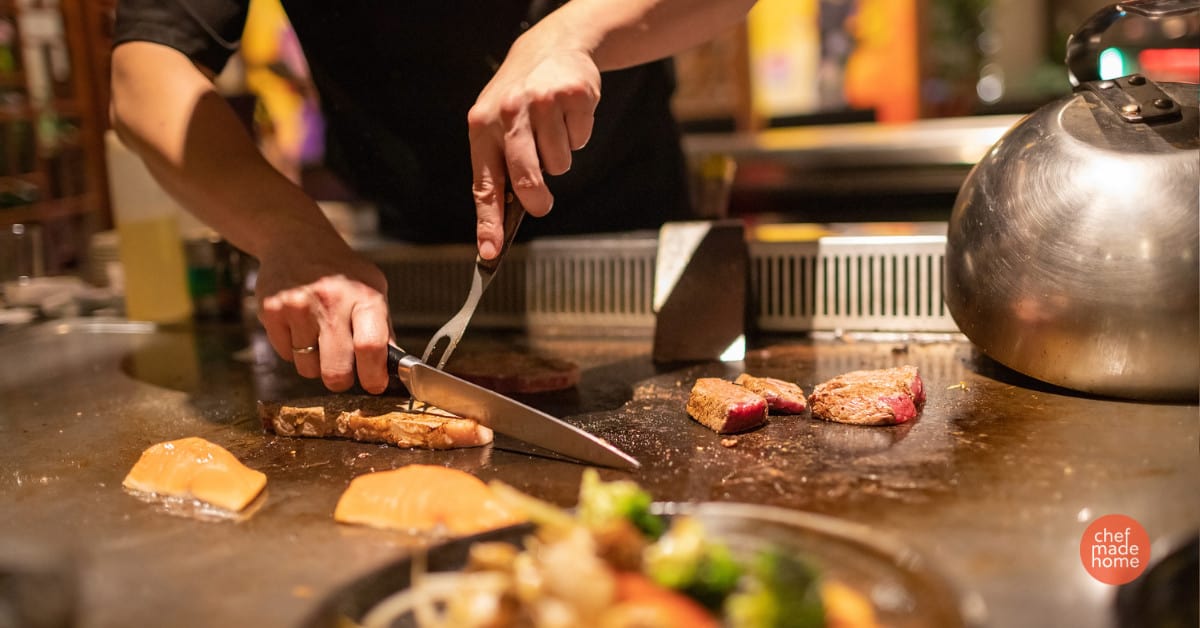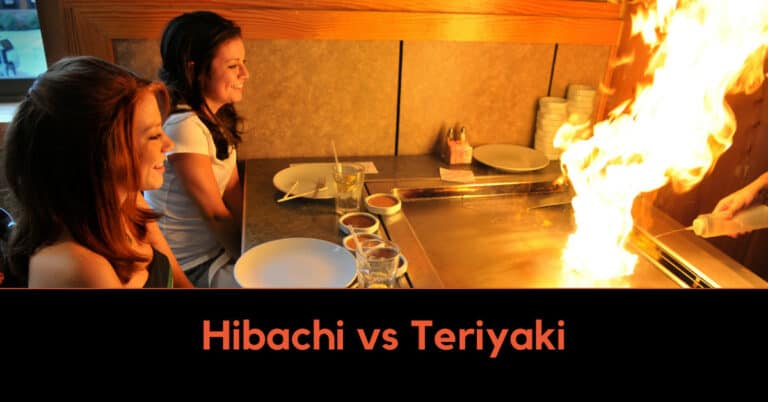SUMMARY: Hibachi and teriyaki are both popular Japanese cooking styles, but they differ in their technique, flavors, and presentation. Hibachi refers to grilling food on a high-heat iron griddle, producing a smoky flavor. At the same time, teriyaki is a cooking method that involves marinating, grilling, or broiling the meat or vegetables in a sweet and savory soy-based glaze.
Are you tired of confusing hibachi and teriyaki?
Do you wonder about the differences between these two popular Asian cuisines?
In this article, I will unravel the mysteries of hibachi and teriyaki, exploring their unique flavors, preparation techniques, and cultural significance. Get ready to tantalize your taste buds and better understand these culinary delights.
Here’s what you can expect to find in this article:
- The Basics: Hibachi
- The Basics: Teriyaki
- Hibachi vs. Teriyaki: Flavor and Texture
- Hibachi vs. Teriyaki: Preparation and Presentation
- Conclusion
Let’s dive into the delicious world of hibachi and teriyaki and discover what sets them apart!
The Basics: Hibachi

Hibachi cuisine encompasses a unique dining experience that combines skilled culinary techniques with interactive tableside cooking. Here’s everything you need to know about hibachi:
Origins and Cultural Significance
- Hibachi traces its roots back to ancient Japan, where it was initially used as a heating device.
- “hibachi” translates to “fire bowl” in Japanese, referring to the traditional charcoal braziers used for cooking.
- Over time, hibachi evolved into a popular style of cooking known for its theatrical flair and communal dining atmosphere.
Key Ingredients and Cooking Techniques
- Hibachi dishes typically feature a variety of fresh meats, seafood, and vegetables.
- The ingredients are often marinated in flavorful sauces or spices to enhance their taste.
- Hibachi cooking involves high-heat grilling on a flat iron griddle known as teppanyaki, allowing for precise control of cooking temperatures.
- Skilled hibachi chefs showcase their expertise by performing impressive knife skills, flipping ingredients in the air, and creating mesmerizing pyrotechnic displays.
The Basics: Teriyaki
Teriyaki cuisine is a popular Japanese cooking style that combines sweet and savory flavors. Its unique taste is achieved through a specific cooking technique and a signature sauce. Here’s some essential information to help you understand teriyaki cuisine:
Definition and Description
- Teriyaki is a Japanese cooking method that involves grilling or broiling meat, fish, or vegetables after marinating them in a sweet soy-based sauce.
- The term “teriyaki” derives from the Japanese words “teri,” which means shine or glaze, and “yaki,” which means grill or broil. This reflects the sauce’s ability to make the food glossy when cooked.
- The key characteristic of teriyaki cuisine is the perfect balance between sweet and savory flavors.
Origins and Cultural Significance
- While teriyaki is now a popular dish worldwide, it originated in Japan and has a long history dating back to the 17th century.
- Initially, teriyaki was developed as a preservation technique for fish and other protein sources. The process involved marinating the food in a mixture of soy sauce, mirin (a sweet rice wine), and sugar to extend its shelf life.
- Over time, teriyaki evolved into a widely loved cooking style and sauce that became an integral part of Japanese cuisine.
- Today, teriyaki is a staple in Japanese households and a popular choice at Japanese restaurants worldwide.
Key Ingredients and Cooking Techniques
- The hallmark ingredient of teriyaki is the teriyaki sauce, which typically consists of soy sauce, mirin, sugar, and sometimes sake or ginger.
- Protein sources commonly used for teriyaki include chicken, beef, pork, and fish, such as salmon or tuna.
- Before grilling or broiling, the protein is marinated in the teriyaki sauce for a specific period to allow the flavors to penetrate and impart a sweet, savory glaze.
- Teriyaki is traditionally cooked over high heat, which creates a caramelization effect on the meat or vegetables, resulting in a flavorful char and succulent texture.

Hibachi vs Teriyaki: Flavor and Texture
When comparing hibachi and teriyaki cuisines, it’s essential to consider the differences in flavor and texture. Both styles offer their own distinct characteristics that appeal to different palates. Let’s explore the variations in flavor profiles and textures of hibachi and teriyaki:
Flavor Profiles
- Hibachi:
- Hibachi cuisine is known for its bold, smoky flavors.
- The dishes often combine umami, sweetness, and mild tanginess.
- Using soy sauce, garlic, ginger, and various spices adds complexity to the flavor profile.
- Hibachi dishes tend to have a savory and robust taste with a hint of charred notes from grilling.
- The flavor profile of hibachi cuisine varies depending on the specific ingredients used, such as seafood, chicken, beef, or vegetables.
- Teriyaki:
- Teriyaki cuisine offers a harmonious blend of sweet and savory flavors.
- With its soy sauce, mirin, and sugar combination, the teriyaki sauce provides a distinctive and delightful taste.
- The sauce caramelizes during cooking, resulting in a slightly sticky glaze that enhances the overall flavor.
- The sweetness of the teriyaki sauce complements the umami flavors of the protein or vegetables, creating a well-balanced taste.
- Teriyaki dishes can range from mildly sweet to more pronounced sweetness, depending on personal preferences and variations in the sauce recipe.
Textures
- Hibachi:
- Hibachi cuisine offers a diverse range of textures.
- The grilling technique used in hibachi cooking creates a delightful contrast between tender and slightly charred elements.
- Meats cooked on the hibachi grill are often juicy and succulent, with a smoky flavor imparted by the grill’s high heat.
- Grilled vegetables in hibachi dishes maintain a crisp texture, enhancing the overall mouthfeel of the dish.
- The interplay of tender and charred elements adds depth to the overall dining experience.
- Teriyaki:
- Teriyaki dishes provide a balance of textures.
- The combination of grill or broil and the caramelization of the sauce creates a slightly charred exterior on the protein while maintaining its juiciness and tenderness.
- Teriyaki-glazed meats are often juicy, with a delicate caramelized crust.
- Whether grilled or stir-fried, vegetables in teriyaki dishes retain their crispness, providing a satisfying crunch.
- Overall, the textures in teriyaki cuisine offer a pleasing contrast between the tender protein and the crispness of the vegetables.
Examples of Dishes
- Hibachi:
- Hibachi-style steak: A tender and juicy steak with a delightful charred crust, served with grilled vegetables.
- Hibachi-style shrimp: Succulent shrimp marinated in a savory sauce, grilled to perfection.
- Hibachi-style mixed vegetables: Crisp and vibrant vegetables lightly seasoned and grilled, complemented by the smoky flavors of the grill.
- Teriyaki:
- Teriyaki chicken: Tender chicken marinated in a sweet and savory teriyaki sauce, grilled or broiled to perfection.
- Teriyaki salmon: A luscious piece of salmon glazed with teriyaki sauce, cooked to achieve a delicate balance of flavors and textures.
- Teriyaki tofu: Soft and silky tofu bites infused with the rich flavors of the teriyaki sauce, offering a vegetarian option with delightful textures.

Hibachi vs Teriyaki: Preparation and Presentation
The preparation methods and presentation styles of hibachi and teriyaki cuisines contribute to the overall dining experience. Understanding these aspects allows us to appreciate each style’s unique characteristics and aesthetics. Let’s delve into the differences in preparation and presentation between hibachi and teriyaki:
Preparation Methods
- Hibachi:
- Hibachi cuisine involves live grilling on a flat metal grill known as a hibachi grill.
- The grill is typically made of cast iron, providing excellent heat retention and even cooking.
- Hibachi chefs, known as “teppanyaki chefs,” skillfully cook the ingredients before diners, creating an interactive and entertaining experience.
- The preparation process often involves expert knife skills, such as intricate vegetable chopping or meat slicing, to ensure even cooking and an appealing presentation.
- Hibachi cooking usually incorporates various techniques, including grilling, searing, stir-frying, and sautéing.
- Teriyaki:
- Teriyaki cuisine mainly marries protein or vegetables in a teriyaki sauce before cooking.
- The marinating process allows the flavors to penetrate the ingredients, infusing them with teriyaki’s signature sweet and savory taste.
- Depending on the recipe, teriyaki dishes can be cooked using various methods such as grilling, broiling, pan-frying, or stir-frying.
- Teriyaki cooking techniques focus on achieving a caramelized glaze on the protein while maintaining the desired tenderness.
Presentation Styles
- Hibachi:
- Hibachi cuisine boasts a visually appealing presentation that showcases the chef’s culinary skills.
- The cooked ingredients are typically arranged artfully on a large plate or grill, creating an enticing display of colors, textures, and shapes.
- Diners can witness the live cooking process, adding an exciting element to the presentation.
- Some hibachi restaurants incorporate other visual elements into the presentation, such as expertly flipping shrimp into diners’ mouths or creating onion volcanoes that release steam.
- Hibachi chefs may also personalize the presentation by assembling the ingredients into aesthetically pleasing shapes, like flowers or animals.
- Teriyaki:
- Teriyaki dishes are often presented in a more minimalist and elegant style.
- The protein, such as chicken, beef, or fish, is typically showcased as the dish’s focal point.
- Teriyaki-glazed proteins are often arranged on a plate alongside complementary components, such as steamed rice, vegetables, or a side salad.
- The caramelized glaze of the teriyaki sauce adds a glossy finish to the protein, enhancing its visual appeal.
- Some Japanese restaurants serving teriyaki may garnish the dish with sesame seeds, thinly sliced green onions, or a sprig of fresh herbs to add a touch of color and freshness.
Rituals and Traditions
- Hibachi:
- Hibachi cooking embraces a sense of spectacle and entertainment, where diners experience the artistry of live cooking.
- It is common for hibachi chefs to showcase their skills by performing tricks, such as spinning utensils or creating theatrical flames on the grill.
- In some hibachi restaurants, chefs may engage diners in interactive games or challenges, adding an element of fun to the dining experience.
- Hibachi dining often promotes a communal atmosphere, with large grills and shared tables encouraging conversation and social interaction.
- Teriyaki:
- While teriyaki dishes may not have as many explicit rituals or traditions as hibachi, they hold cultural significance in Japanese cuisine.
- The preparation and execution of teriyaki dishes adhere to the artistry of Japanese culinary traditions, ensuring the perfect balance of flavors and textures.
- Teriyaki is a versatile sauce that can be adapted to various proteins and vegetables, allowing for creativity in recipe development while still honoring the dish’s essence.
- In its simple yet elegant presentation, Teriyaki reflects the Japanese aesthetics of simplicity, harmony, and balance.
Key Takeaways
In conclusion, understanding the differences between hibachi and teriyaki cuisine allows you to fully appreciate and savor the flavors and experiences they bring. Throughout this article, we have explored the basics of hibachi and teriyaki, delved into their unique flavor profiles and textures, examined their preparation methods and presentation styles and debunked common misconceptions. As you wrap up your journey through this culinary exploration, here are the key takeaways to remember:
- Hibachi cuisine is characterized by grilling techniques and an emphasis on fresh ingredients. In contrast, teriyaki cuisine is defined by using sweet and savory sauces.
- Hibachi imparts a smoky, seared flavor, whereas teriyaki showcases a delightful blend of sweetness and umami.
- Texture-wise, hibachi dishes often have a charred and slightly crispy exterior. In contrast, teriyaki dishes feature a tender and succulent quality.
- Hibachi and teriyaki have distinct preparation techniques and presentation styles, with hibachi emphasizing live cooking directly in front of diners and teriyaki favoring marination and pan-grilling.
- Misconceptions such as teriyaki being exclusively made on a hibachi grill or hibachi sauce being the same as teriyaki sauce are debunked.
With these newfound insights, you can confidently decide which cuisine to enjoy based on your preferences. Be it the vibrant display of flames and sizzling ingredients at a hibachi grill or the tantalizing aroma of marinated meats infused with teriyaki sauce, both hibachi and teriyaki offer unique and gratifying culinary experiences.
FAQ
Can teriyaki be made on a hibachi grill?
Yes, teriyaki can be made on a hibachi grill. While hibachi cuisine traditionally uses grilling techniques, teriyaki is a versatile sauce that can be applied to various cooking methods, including hibachi.
Is hibachi sauce the same as teriyaki sauce?
No, hibachi sauce is not the same as teriyaki sauce. Hibachi sauce, or “yum yum sauce” or “Japanese steakhouse sauce,” typically consists of mayonnaise, ketchup, garlic powder, and other seasonings, resulting in a creamy and tangy condiment. On the other hand, teriyaki sauce is a sweet and savory glaze made from soy sauce, mirin, sugar, and sometimes ginger, creating a distinct flavor that complements a variety of dishes.
Are hibachi and teriyaki dishes gluten-free?
While both hibachi and teriyaki dishes can be gluten-free, it is crucial to check the ingredients and cooking methods used by the specific restaurant or chef. Some variations of hibachi and teriyaki sauce may include soy sauce, which contains gluten. It is recommended to inform the staff about dietary restrictions or allergies to ensure a safe and suitable meal.
Can hibachi and teriyaki be enjoyed by vegetarians or vegans?
Yes, hibachi and teriyaki dishes can be adapted to cater to vegetarian or vegan diets. For hibachi, vegetables, tofu, or plant-based proteins can be substituted for meat, and grilling techniques can be used accordingly. As for teriyaki, a similar versatility applies, allowing for the creation of flavorful sauces and glazes that complement vegetarian or vegan ingredients. Communicating your dietary preferences to the restaurant or chef is always advisable to accommodate your needs.
Are hibachi and teriyaki exclusively Japanese cuisines?
Hibachi and teriyaki are strongly associated with Japanese cuisine. Still, they have gained popularity and have been adopted in various parts of the world. While their origins lie in Japanese culinary traditions, you may find variations or fusions of hibachi and teriyaki in different countries, showcasing the global appeal of these delicious flavors.
Remember, if you have any further questions or inquiries about hibachi, teriyaki, or Japanese cuisine, don’t hesitate to consult with your local experts or explore more authentic resources. Happy dining and culinary exploration!

